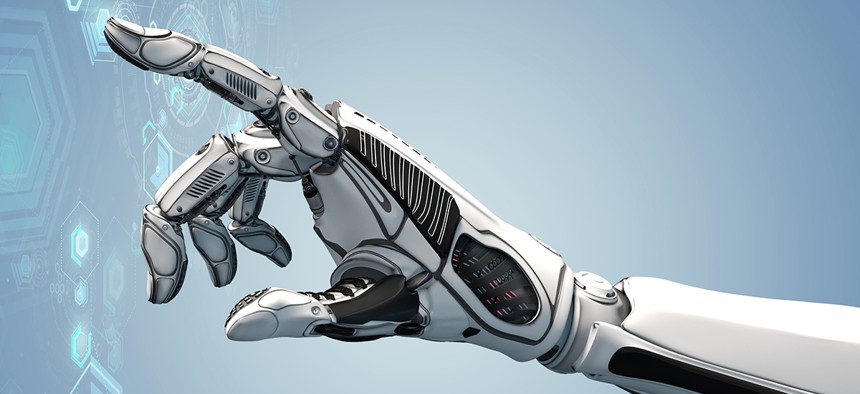Augmented Humans: Next Great Frontier, or Battleground?

Willyam Bradberry/Shutterstock.com
Before you dismiss it as pure science fiction, consider how close augmented human technologies are to radically leaping forward, and into the mainstream – and the issues they could realistically cause.
John Breeden II is an award-winning journalist and reviewer with over 20 years of experience covering technology and government. He is currently the CEO of the Tech Writers Bureau, a group that creates technological thought leadership content for organizations of all sizes. Twitter: @LabGuys
This story has been updated to reflect that the organizer of the conference is Courageous.
It seems like, in general, technology always races ahead of the moral implications of using it. This seems to be true of everything from atomic power to sequencing genomes. Scientists often create something because they can, because there is a perceived need for it, or even by accident as a result of research. Only then does the public catch up and start to form an opinion on the issue.
Look at cloning as a recent example. Everyone thought it was impossible until Dolly the sheep proved it could happen in 1996. In fact, Dolly was cloned from a normal body cell, which proved that almost any cell could be used for cloning, not just those specialized reproductive cells we all know about.
Since then, many more animals have been cloned, even a Pyrenean ibex ram whose species had had gone extinct in 2000. During that time, nobody much cared about cloning animals. But when the question of human cloning came up, there was quite a pushback.
» Get the best federal technology news and ideas delivered right to your inbox. Sign up here.
About 70 countries around the world reacted to quickly ban human cloning or to prevent public funding from going toward cloning research. The United States has no such law in place; however, some individual states including Virginia and Maryland do ban reproductive cloning, the full process of creating a human from a cloned embryo.
All those laws were put in place preventatively, as no examples of human cloning have yet surfaced. Other than cool TV shows like “Orphan Black,” there probably aren't any actual clones out there despite the outcry.
Which brings us to the science of augmenting humans with technology, a process that has so far escaped the public scrutiny and opposition found with other radical sciences. Scientists are not taking any chances, with several yearly conferences already in place as a forum for scientists, futurists and others to discuss the process of human augmentation and the moral implications of the new science.
That said, it seems like those who would normally oppose something like this have remained largely silent.
That acceptance might be based on the fact that current human augmentations are in the very early stages. Take the RoboGlove, developed by NASA and General Motors as an example. It's a glove that helps augment basic human strength and endurance to do things like spin bolts or apply pressure to a wrench. A valuable tool to be sure, but one users can simply remove once the repair is complete.
A little bit closer to Earth, my editor and good friend, Nextgov Executive Editor Camille Tuutti, was recently a bit more permanently augmented by having a chip implanted inside her hand. She's from Sweden originally, and tells me people there can use the embedded chips to open the door to their apartment or to gain access to certain buildings. I don't know if she has found any uses for it around D.C. yet, as she is currently the only person I know who could be classified as a cyborg, but it’s pretty cool nonetheless.
I started thinking about the issues surrounding augmenting humans because of a video game, something that is an oddly common occurrence with me. The new “Deus Ex: Mankind Divided” title is coming out in August, and it proposes a not-too-distant future scenario where humanity is divided into opposing camps of pure humans and those who have been augmented.
Before you dismiss that idea as pure science fiction, consider how close these augmented human technologies are to radically leaping forward, and into the mainstream – and the issues they could realistically cause. Nobody would likely have a problem with a paralyzed veteran, or even just a normal person, putting on an exoskeleton and being able to walk again.
But what about a healthy person electing to have their natural arms or legs removed and replaced with augmented ones that give them super strength and endurance? What about someone who adds a recording or scanning device to their eyeball? What if augmented people, with their massive technological advantages, start to take jobs away from pure humans who can’t afford, or don’t want, to be augmented?
Apparently, I am not the only one contemplating these things. Courageous, a CNN-branded content studio, is hosting a one-day augmented human conference in New York called “Human by Design” in August. The plan is to bring in quite a few noted doctors, scientists, authors and experts to discuss the many issues that could happen once the current level of human augmentation technologies advance.
Those who haven’t really thought about augmenting humans should probably take a moment to do so, because that future, even if not as glossy as the game may make it seem, is probably a lot closer than most would ever expect.



